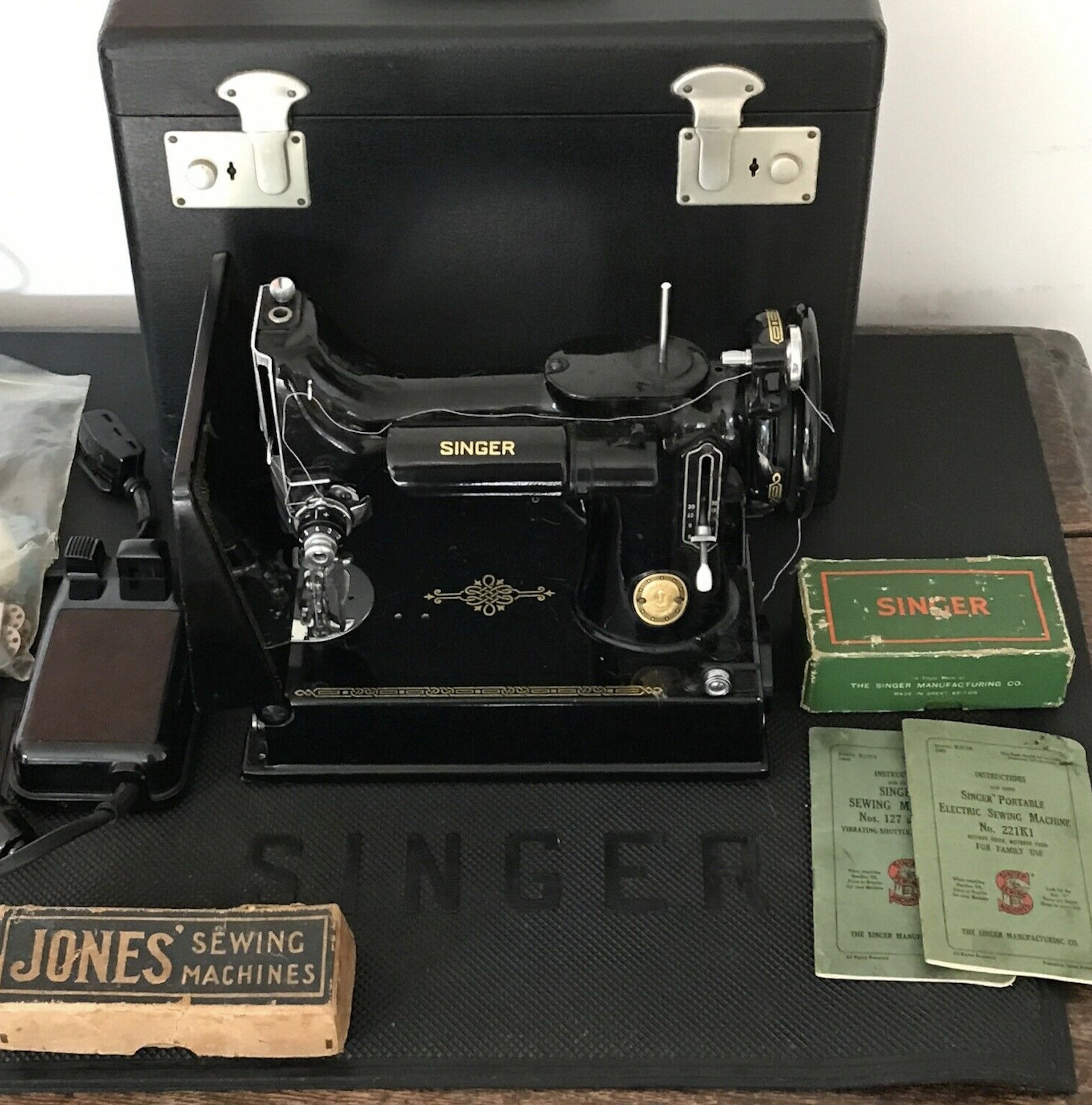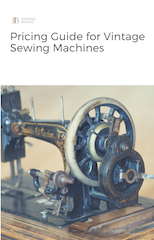Vintage sewing machines are becoming increasingly popular as more and more people appreciate the quality and craftsmanship that goes into these pieces. If you’re thinking of investing in a vintage machine, it’s important to be aware of the going rates for different models.
Are you in the market for a vintage sewing machine?
Vintage sewing Machines are unique pieces of machinery that can be used for a variety of purposes. They can be used to create new clothes, mend old clothes, or even create home decor. If you’re looking for a unique addition to your crafting supplies, then a vintage sewing machine may be right for you.
Buy the expanded -version of this article as a digital download.
Pricing Guide for Vintage Sewing Machine
In this guide, we’ll provide pricing information for vintage sewing machines. With this information, you’ll be able to shop with confidence and find the perfect machine for your needs. Let’s get started!
What to look for when buying a vintage sewing machine
When shopping for a vintage sewing machine, there are a few things you’ll want to keep in mind.
- Consider the condition of the machine. Is it in good working order?
- Think about what you’ll be using the machine for. If you’re planning on using it for heavy-duty projects, then you’ll need a machine that’s capable of handling the workload.
- Consider your budget. Some vintage machines can be expensive, but most are cheaper so you will find plenty of budget-friendly options, if you know where to look.
The following is a pricing guide for some of the most popular vintage sewing machines on the market. Keep in mind that prices may vary depending on the condition of the machine and the seller.
How to determine the value of a vintage sewing machine
A good place to begin your search for the ideal antique sewing machine is with the information provided in this article.
When choosing a vintage sewing machine, it is important first to find the model that meets your specific needs and then evaluate the specific machine’s condition before making a final decision on price.
This guide is divided into three sections:
- Various price points
- Checklist for Adjusting Prices
- Tips for determining prices
Various price points
The first time you look for a vintage sewing machine, you’ll notice a wide variety of models at varying prices. You might feel quite intimidated by it all! No worries – we’ll give you the information you will need to sort it all out.
- Choose the model you’re interested in. This will reduce the number of machines you need to consider and help you learn all there is about that particular model. As soon as you have a solid understanding of that one model, you can decide how much you want to pay.
- Determine what price you are willing to pay for it. You will need to decide on the condition, your ability, and how much effort you would like to put into restoring the machine, as well as where you will look for it. You’ll need to consider all of these factors when you’re deciding what price to pay.
Checklist for Adjusting Prices
Now that you’ve decided on the model and what you’re willing to pay, it’s time to get into the nitty-gritty of it all – the actual prices.
Here is a checklist of items to keep in mind when evaluating a machine:
- The model number
- The age of the machine
- The condition of the machine
- If it is electric or manual
- The completeness of the machine (accessories, original box, manuals, etc)
- Any restoration that has been done to the machine
A rusty sewing machine can be bad news. Some parts of the machine may have been ruined by water. A little surface rust can be polished away, but a machine that has a lot of rust should be avoided.
It’s possible to buy a lot of parts for your sewing machine online, but you’ll have to do your research and pay for them, which can be pricey depending on what you need and how old your machine is.
Wrecked Wiring
If you have the right tools, you can usually tell if the wiring is broken. It does, however, take a lot more work than just wiping down the surface of the sewing machine.
- Can you repair it on your own? N, then forget about it.
- Is the wiring broken? Y, then forget about it.
- The answer is yes. If you can buy parts, you should think about it.
Stitching quality
The stitching quality is important, but it can be fixed. If you’re not planning on using the machine for heavy-duty projects, then you can probably get away with some light repairs.
Make sure the machine makes a stitch. A sewing machine doesn’t start sewing just because the needle moves. If the machine you’re thinking about runs, try sewing with a scrap of fabric to see how well it works. If the machine doesn’t work, move on.
Manual or Electric?
This is an important question to ask yourself when you’re looking for a vintage sewing machine. If you’re not sure how to use a manual machine, then it’s probably not worth your time and money.
However, if you’re looking for a machine that’s going to be used for light projects, then an electric machine might be the way to go.
The cabinet
Most cabinets or cases will show some signs of wear, but it is up to each person how much and what kind of damage they want. Unless you know how to fix wood, don’t buy a cabinet that has structural damage or a lot of de-lamination.
Is the cabinet broken? Yes, then think about not doing it.
Cabinet repairs are difficult and can be costly. Is there a new cabinet that is the right size for your machine?
Attachments
Some machines come with attachments, while others do not. If the machine you’re interested in doesn’t have any attachments, it might be difficult to find them later on. Singer sewing machines came with a lot of different attachments as a standard thing. While I like to get the standard attachments with my new machine, this is a decision that only I can make.
Are there any attachments? Yes, then it’s a good deal.
No, then the price should be lowered.
Are there any attachments? No, if you can’t buy them and want them, then you don’t buy the machine.
Tips for determining prices
Price Setting Tips provides you with suggestions on negotiating a better price for your sewing machine.
- Is the machine dirty? A dirty, neglected machine can give you a great opportunity to negotiate a lower price. It indicates that the seller probably doesn’t know much about the machine, doesn’t value it, and doesn’t know how easy it is to clean up.
- Is the surface of the machine worn? Of course, there will be wear on a vintage sewing machine – it’s old! The machine bed is often scratched or decals worn as fabric passes over it again and again during the sewing process. These marks don’t affect the functionality of the machine, but the machine doesn’t look “pretty”. You can negotiate a lower price if the machine is very worn.
- Is there an easily replaceable part missing? This can be a huge negotiating factor. If the part appears to be major but is easily and inexpensively replaceable from an online source, you can negotiate a fantastic deal. The seller won’t know this, but if you’ve done your research, you will!
- Is this a machine from a private seller? This is where the best opportunities for a good deal are found. Most private sellers do not have an appreciation of what they are selling, nor knowledge of its worth. This is where your knowledge gives you a huge advantage.
Factors that influence the price of a vintage sewing machine
The following factors can impact the price of a vintage sewing machine:
- The condition of the machine
- Whether or not the machine is complete
- The age of the machine
- The rarity of the machine
- The desirability of the machine model
Keep these things in mind when you are pricing your vintage sewing machines!
Where to find vintage sewing machines for sale
Prices for vintage sewing machines vary depending on the machine’s condition and rarity. However, as a general rule of thumb, prices for vintage sewing machines start at around $50 and can go up to $500 or more for rare Singer models.
There are a few different places you can look for vintage sewing machines for sale. Here are a few of the most popular:
- eBay
- Local antique stores
- Online classified ads
- Garage sales
When you are looking for a vintage sewing machine, keep in mind that you should inspect the machine before purchasing it. Make sure to check for things like rust, missing parts, and damage. Also, be sure to test the machine to make sure it is in working condition.
Tips for negotiating the price of a vintage sewing machine
If you find a vintage sewing machine that you are interested in but the asking price is too high, don’t be afraid to negotiate. Here are a few tips to help you get the best deal possible:
- Do your research ahead of time and know how much the machine is worth. This will give you a good starting point for negotiating.
- Be polite and respectful when negotiating. The seller is more likely to be willing to negotiate if they feel like you are a reasonable person.
- Don’t be afraid to walk away from a deal if the price is too high. There are plenty of other vintage sewing machines out there, so don’t feel rushed into making a purchase.
With these tips in mind, you should be able to get a great deal on a vintage sewing machine. Happy shopping!
Final Thoughts
Purchasing a vintage sewing machine can be a great way to get a high-quality machine at a fraction of the price of a new one. However, it is important to do your research and know what you are looking for before making a purchase. With a little bit of patience and effort, you should be able to find a great vintage sewing machine at a reasonable price. Happy hunting! Here are some vintage models available on ebay.com



